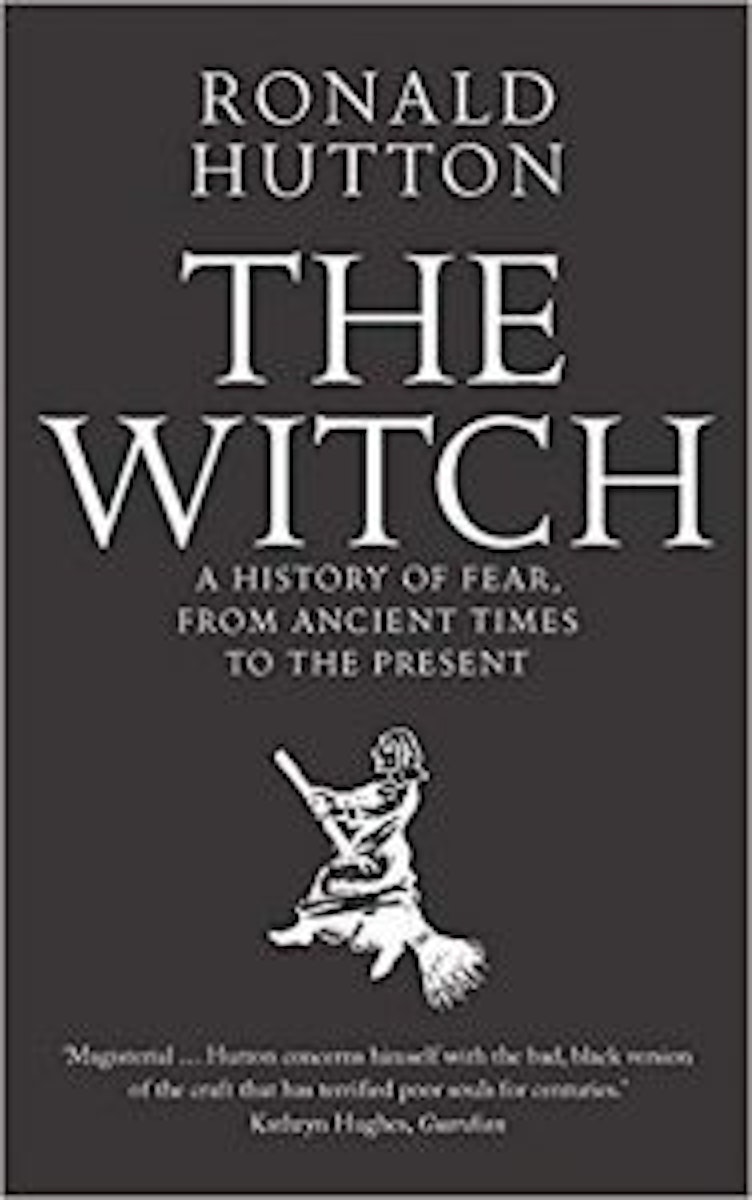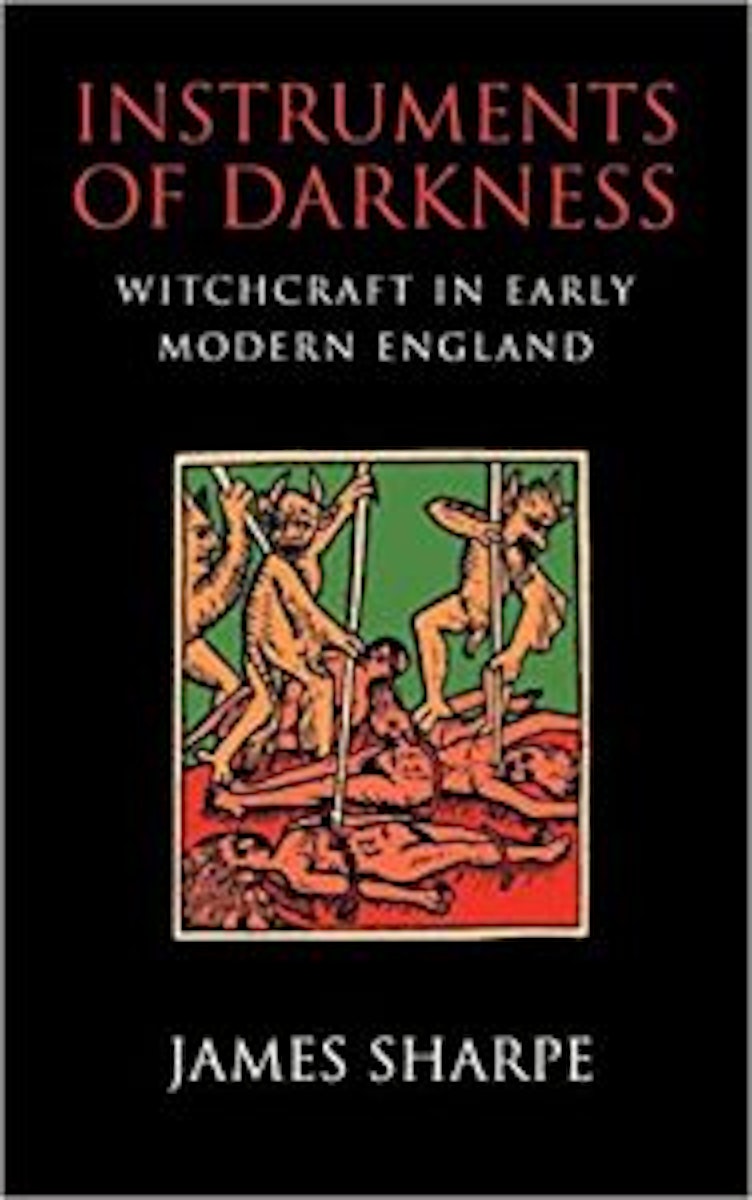
Divining the Witch of York Propaganda and Prophecy
Said to be spawn of the devil himself and possessed with great powers of prophetic insight, Mother Shipton was Yorkshire’s answer to Nostradamus. Ed Simon looks into how, regardless of whether this prophetess witch actually existed or not, the legend of Mother Shipton has wielded great power for centuries — from the turmoil of Tudor courts, through the frictions of civil war, to the spectre of Victorian apocalypse.
October 24, 2018
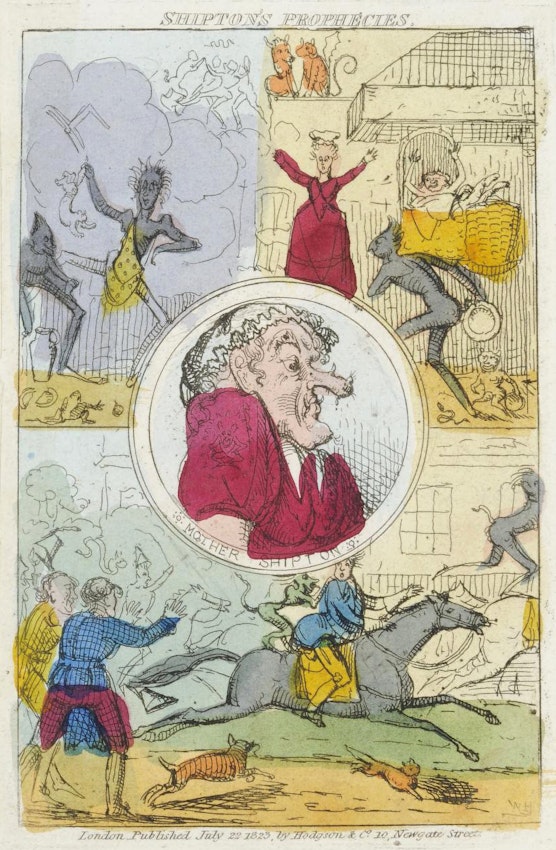 Scroll through the whole page to download all images before printing.
Scroll through the whole page to download all images before printing.Frontispiece, most likely by Robert Cruikshank, to The Life and Prophecies of Mother Shipton (1823) — Source.
In 1488 during the reign of Henry VII, one year after the Dominican Heinrich Kramer wrote his notorious witch-finding manual Malleus Maleficarum, an adolescent girl named Agatha Soothtell gave birth in a cave among the dales and moors of Yorkshire to her daughter Ursula, supposedly conceived by the Devil himself. Ironically it was there in “God’s Own Country” that young Agatha would raise her demonic charge, both of them forced to live in the cave where Ursula was born. The site that would be visited by pilgrims for centuries afterwards, making it arguably England’s first tourist attraction, was known as much for the strange calcifying waters of its subterranean whirlpool as for its medieval Satanic nativity.
Most sources claimed that Ursula died during the rule of Elizabeth I in 1561, but with eight decades separating her supposed death and the first appearance of her name in print, it’s fair to assume a degree of invention in her biography. Despite her legendary ugliness (Ursula’s seventeenth-century biographer described her as “a thing so strange in an infant, that no age can parallel”1), at the age of twenty-four she married a carpenter named Toby Shipton, and it is to posterity that she would come to be known as “Mother Shipton”. A less appropriate surname, because as “Smith” and “Taylor” indicate profession, so too did “Soothtell”. Mother Shipton would become the most famed of soothe tellers in English history, renowned for her prophecies and used as a symbolic familiar in the art of divination for generations, the very constructed personage of the seer, a work of poetry unto herself. As scholar Darren Oldridge writes, “Unlike other ‘ancient prophets’ who were known by their words alone, Shipton emerged as a personality in her own right”.2
It is likely at least some of Mother Shipton’s predictions were invented long after she lived, her prophetic couplets revised and edited to conform to later events, whether Cardinal Wolsey’s death, the Great Fire of London, or the Crimean War. Details of her biography, her writing, and her very countenance are uncertain. The prophetess herself may have been a later invention. Yet Mother Shipton, England’s Nostradamus, the sixteenth-century Sibyl, the Yorkshire prophetess, the Knaresborough witch whose crooked face has stared out from prints hanging on occultist’s walls and in the names of country pubs since the initial printing of her predictions in 1641, should serve as a potent point of reflection for what exactly we talk about when we talk about prophecies.
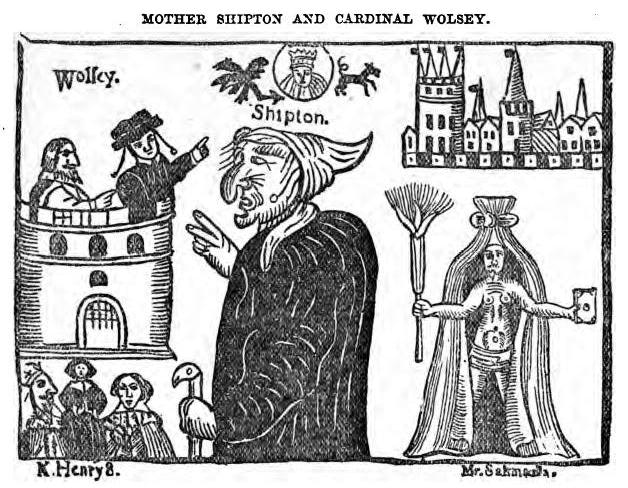 Scroll through the whole page to download all images before printing.
Scroll through the whole page to download all images before printing.Illustration from Mother Shipton Investigated (1881) by William Henry Harrison — Source.
Most of the major events in British history found expression in some pamphlet or compendium of Mother Shipton’s predictions, albeit backdated retrospectively with great convenience. There is Elizabeth I’s reformation: “A maiden Queen shall reign anon. / The Papal power shall bear no sway, / Rome’s creed shall hence be swept away.” Mother Shipton supposedly saw those broken ships of the Spanish Armada off the English and Irish coast: “The Western monarch’s wooden horses / Shall be destroyed by Drake’s forces” (a rare case of a prediction specifically naming a historical figure, which a skeptic might use to question said prophecy’s authenticity). It was claimed that the witch had a vision of Mary, Queen of Scots’ execution: “a widowed Queen / In England shall be headless seen”, as well as the punishment of Essex for his rebellion: “An Earl without a head be found”, and the ascension of the Scottish King James VI to the throne in Westminster: “Soon after shall the English Rose / Unto a male her place dispose.”3 And then there’s the Great Fire of London in 1666, Mother Shipton having supposedly claimed that “it comes against London . . . what a good city this was, none in the world comparable to it, and now there’s scare a house left,”4 which apparently led the diarist, raconteur, and naval secretary Samuel Pepys to write “Mother Shipton’s word is out”.5
As mentioned, some scholars have argued that she is a complete fiction. There are those, however, that argue she was in some way an actual person, embellished through local tradition into a folk legend. There is at least one clue earlier than the seventeenth century which indicates that the prophetess may be based in more than pure invention. In 1537, as Catholic rebels in Yorkshire rebelled against Henry VIII and his dissolution of the monasteries, the assailed king wrote a letter to the Duke of Norfolk in which he disdainfully refers to a “witch of York”. It is perhaps the earliest reference to what may be the real Mother Shipton. As the anonymous author in an 1868 edition of Notes and Queries concluded, “Although the fact of the existence of Mother Shipton rests wholly upon Yorkshire tradition, she can scarcely be regarded as a myth.”6
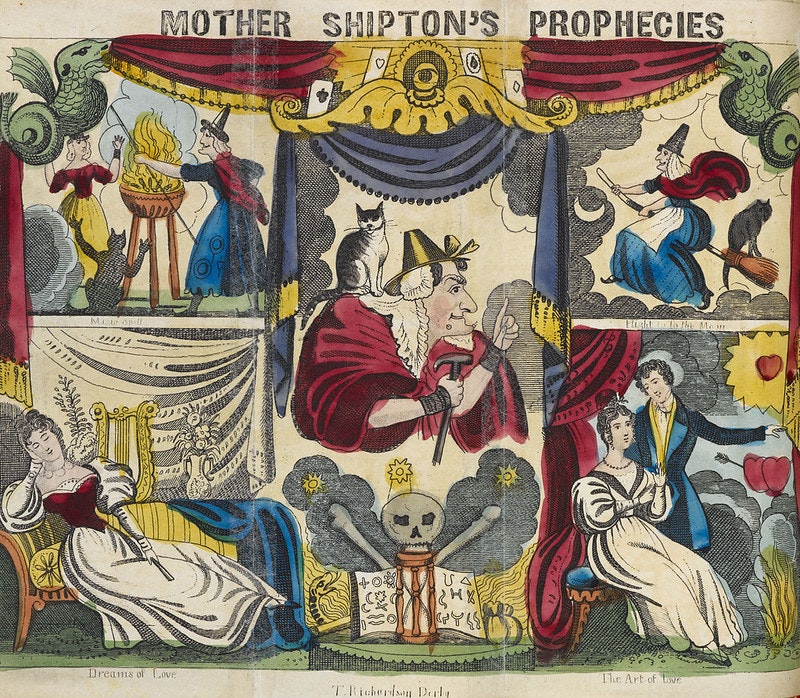 Scroll through the whole page to download all images before printing.
Scroll through the whole page to download all images before printing.Illustration from Mother Shipton’s Wheel of Fortune; By Means of which you may Learn your Future Destiny (ca. 1838) — Source.
The British Library’s earliest listed publication about Mother Shipton is the anonymously penned 1641 The Prophesie of Mother Shipton in the raigne of King Henry the Eighth, fortelling the death of Cardinall Wolsey, etc., with fifteen subsequent texts in the seventeenth century (including a play), and dozens more published in the intervening centuries. One particular title was crucial to the embellishment of her myth, her biography as written by the Irish novelist Richard Head in 1667. Notes and Queries described Head as “the notorious Richard Head, author of several works of loose description.”7 His oeuvre included the erotic poetry of Venus Cabinet Unlock’d, the earliest slang dictionary The Canting Academy, a work of true crime about a notorious highwayman called Jackson’s Recantation, and, most significantly, a picaresque novel titled The English Rogue. That last title would become the first major fiction in English to be translated into a foreign tongue and would influence authors such as Daniel Defoe, who was inspired to write Moll Flanders based on Head’s example.
Head’s The Life and Death of Mother Shipton was responsible for the majority of invented biographical details, building upon the bare narrative scaffolding of dozens of popular pamphlets. From Head’s imagination came details such as Agatha’s demonic wedding feast with Satan, accounts of magical feats performed by Ursula in front of worthies such as Cardinal Wolsey, and, most enduringly, the graphic and purple description of Mother Shipton’s physical appearance, which occupies hundreds of words, describing her as “very morose and big-boned”, with “very great goggling, but sharp and firey eyes; her nose of an incredible and unproportionable length”. Head then goes on for several sentences describing said nose in magnificently baroque prose, its “many crooks and turnings,” and its adornment with “many strange pimples of divers colours, as red and blue mixed, which, like vapours of brimstone, gave such a lustre to the affrighted spectators in the dead time of the night, that one of them confessed several times, that her nurse needed no other light” to assist her in the birth of the prophetess. Head offers similarly purple descriptions of Mother Shipton’s cheeks, her teeth, her mouth, her neck, her shoulders, her legs, and her toes, telling us that it was as if “her body had been screwed together piece after piece, and not rightly placed”. In short, Head rather cruelly makes clear what Mother Shipton looked like — a witch.8 Although not the origin of the Shipton myth, Head’s portrait is its most enduring instance, and it has almost single-handedly propelled Mother Shipton’s rise into full-on prophetic stardom.
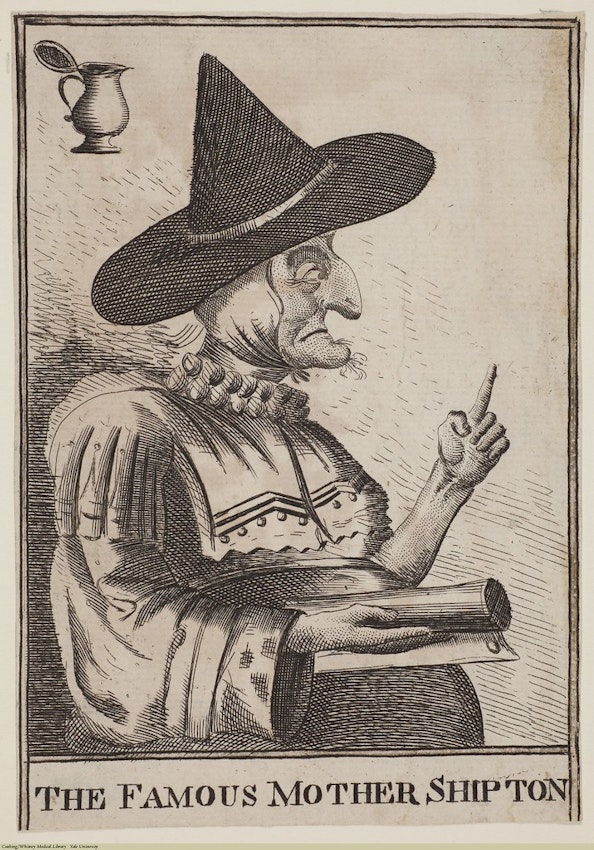 Scroll through the whole page to download all images before printing.
Scroll through the whole page to download all images before printing.The Famous Mother Shipton, artist and date unknown — Source.
“The prophet is, first and foremost, a media phenomenon”, writes historian Jonathan Green in Printing and Prophecy: Prognostication and Media Change 1450-1550, and if Mother Shipton was anything, it was a veritable media phenomenon.9 A beneficiary of cheap print, her stock soared with the collapse of the licensing laws of the 1640s, which enabled a deluge of pamphlets ascribing to her any number of potentially contradictory predictions. Pamphleteers during the years of the English Civil War took ample opportunity to enlist Mother Shipton as a convenient authority in propagandistic causes, both Parliamentarian and Royalist. Scholar Harry Rusche, in the English Historical Review, writes that
Virtually all prophecies possessed a potential propaganda value that could be exploited by clever interpretation or a slight revision, and no prophetic utterance, ancient or recent, was so innocent that it could not be ingeniously twisted to bear upon contemporary religious and political issues.10
Such invoking of prophecies during times of crisis, writes historian Madeline Dodds, was “usually to demonstrate that some drastic change, either desired or already accomplished, had been foreseen by the sages of the past.”11 And this was often achieved by the retroactive backdating of prophecies, something certainly true for Head writing during the years of Restoration. Consider the explicitly Royalist gloss of the following, in which Mother Shipton “predicts” the regicide of Charles I, all via the pen of Head writing eighteen years after the actual event: “Then shall the Council great assemble, / Who shall make great and small to tremble, / The White King then (O grief to see!) / By wicked hands shall murdered be.” Head informs his readers that Shipton saw the rule of Charles’ son, “predicted” in this pamphlet published seven years into his rule, for “fate to England shall restore / A king to reign as heretofore.”
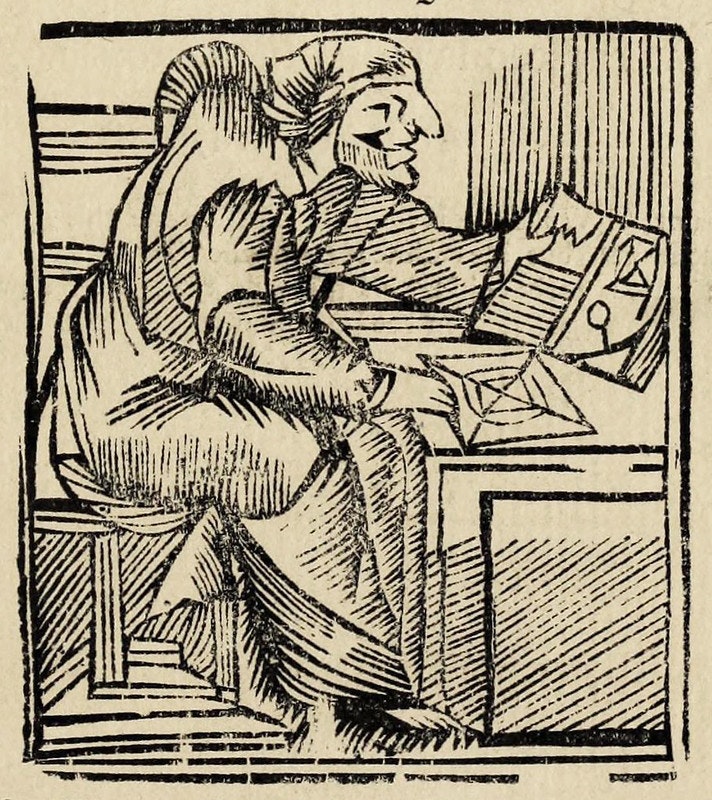 Scroll through the whole page to download all images before printing.
Scroll through the whole page to download all images before printing.Image from the title page to The Strange and Wonderful History of Mother Shipton (1686) — Source.
By contrast, the 1641 Mother Shipton pamphlet evidences Parliamentarian sympathies, presenting startlingly accurate predictions about the future rather than only backdating events that had already occurred. It is claimed that “Wars shall begin in the Spring, / Much war to England it shall bring: / Then shall the Ladies cry well-away, / That ever we liv’d to see this day.”12 Though written with a sense of melancholia, there is also a sentiment of inevitability and the accurate foresight of coming civil war (though written after the Bishop’s War had already seen Scotland and England at blows). Moving from verse to prose, Mother Shipton prophecies that despite the coming strife, ultimately “there shall never be warfare again, nor any more Kings or Queens,” a startlingly radical conclusion written some eight years before Charles I would place his neck on the block. Rusch notes, “Whether this was specifically meant as parliamentarian propaganda is difficult to say” and that 1641 “seems too early for this kind of speculation except in the most extreme factions.” Yet whether the pamphlet originated in those extreme factions (or was simply accurate divination!), Rusche does observe that the publication “came to be recognized as good material for the parliamentarians. . . [and] was subsequently published by those opposed to the principles of monarchy.”13
If, during the politically tumultuous 1640s, the use of Mother Shipton’s prophecies centred on justifying or rebelling against rule, then later versions saw a different focus. Her most famous prophetic couplet, which claims that “The world to an end shall come, / In eighteen hundred and eighty one”,14 first appeared in an 1862 edition of her prophecies edited by Charles Hindley, a Victorian writer who was known for his compilations of vulgar speech, such as his omnibus Curiosities of Street Literature. His edition of Mother Shipton’s predictions reinvigorated the legends about the Yorkshire oracle, and if Head’s biography is one node in her myth, then Hindley supplied the other. Clifford Musgrave writes in Life in Brighton, from the Earliest Times to the Present that Hindley’s ominous apocalyptic verse “had an extraordinary effect on the popular imagination, especially among the poor educated and more credulous people all over the countryside.” According to Musgrave, many of these people “deserted their homes and spent nights praying in the fields, churches and chapels.”15 So pervasive was the fear that the world would end in 1881 that the British Library employed William Henry Harrison (not to be confused with the US president) to write an exhaustive debunking of the legend titled Mother Shipton Investigated. Harrison quotes the editor of an 1873 edition of Notes and Queries who explained that “Mr. Charles Hindley, of Brighton, in a letter to us, has made a clean breast of having fabricated the Prophecy quoted”, thus demonstrating once and for all the complete fabrication that was the Sibyl’s most famous and frightening prediction.16
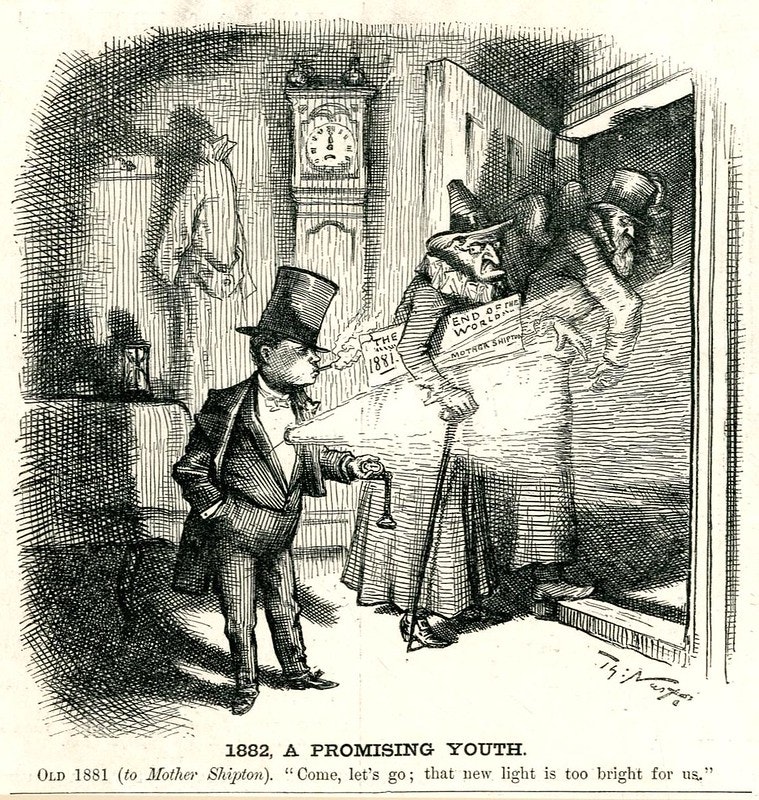 Scroll through the whole page to download all images before printing.
Scroll through the whole page to download all images before printing.1882, A Promising Youth (1882), a cartoon by Thomas Nast for Harpers Weekly — Source.
It is not only fear that motivates allegiance to such prophecies; involved here also is a yearning for meaning and significance — the idea perhaps that our own lives could be of such importance that a Tudor oracle may have dreamt of us. As James Sharpe explains in Instruments of Darkness: Witchcraft in Early Modern England, prophecies “helped many people make sense of the world and cosmos in which they existed, and helped them deal with at least some of the problems they experienced”, even when such predictions were of apocalyptic bent.17 Consider not just the concluding apocalyptic couplet, but the full prophecy presented by Hindley, where he has the Sibyl say that “Through hills man shall ride, / And no horse be at his side. / Under water men shall walk, / Shall ride, shall sleep, shall talk. / In the air men shall be seen, / . . . Iron in the water shall float, / As easily as a wooden boat.”18 It is difficult to read her couplets and not imagine these prophecies rendered in such pleasing anaphora, repetition, and tricolon, to be eerily aligned to our own present, evoking cars or scuba diving, airplanes, or cruise ships. Perhaps Hindley had the telegraph in mind, but it’s hard not to see a reflection of ourselves in the black mirror of our smartphones and laptops as you read that “Around the world thoughts shall fly / In the twinkling of an eye.”19
Looking for such insight in ancient divinations betrays a poignant sentiment: that in past prophecies we hope not just for predictive power, but also for evidence of a connection with times long past — a sense that we are not so alone, cut-off and adrift in our particular age, but rather characters in a narrative penned long ago. More than being simple prediction, prophecy seems a strange literary tense that confuses past, present, and future, and inserts those not yet born into the writings of antiquity. Green explains that “prophecy involves; above all, the claim, made by the prophet and understood by his or her followers, to be the middle participant in a two-part conversation.”20 The scouring of prophecies, pamphlets, letters, marginalia, ephemera, and almanacs of those prophetic mages is driven by the desire for a radical, sweet empathy imparted to us by our long-dead ancestors. Reading Nostradamus, or those weird sisters the Sibylline oracles, or some other mystic, seer, or psychic is to wish that we could speak to the past, that our dialogues with the dead are not one-sided and that perhaps they cared about us.
While scholars have written extensively about more respectable (and verifiably real) astrologers and alchemists who mastered the necromantic arts, from John Dee in the sixteenth century to Simon Forman and William Lilly in the seventeenth (the latter an author of a pamphlet about Mother Shipton), the “cunning-woman” of Yorkshire has remained the province of psychics and tarot card readers, hazily remembered as just another antique prophetess. Distinctions between those gentlemen with their grimoires, scrying mirrors, and alchemical tables and the hag of Yorkshire might not be as historically clear as could be assumed. Sharpe explains that a “distinction between witchcraft on the one hand and magic and sorcery on the other proves impossible”, and that “medieval and early modern commentators tended to jumble the terms [of witchcraft and magic] together happily enough.”21 Certainly there has been a rich and full investigation of witchcraft by social historians over the past half-century, yet Mother Shipton herself awaits her full due -- a debt which may continue to be deferred so long as proof of her existence eludes us. Despite much (or even perhaps all) of her biography and her supposed fortunes being the result of hoax, invention, conjecture, and fiction, there is a cracked truth in her example. For even in her most famed, fake, and falsified predictions we are given the opportunity to contemplate this strange thing of prophecy, in both its propaganda and its poetry, while also perhaps encountering the witch of York on her own terms, seeing predictions for what they are: a weird type of participatory literature.
Ed Simon is a staff writer for The Millions, which the New York Times has called the “indispensable literary site”. A specialist in early modern and early American literature, he holds a PhD in English from Lehigh University, and his most recent book is Printed in Utopia: The Renaissance's Radicalism (Zero Books, 2020).





